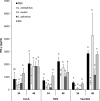Oral treatment of chickens with lactobacilli influences elicitation of immune responses
- PMID: 21734067
- PMCID: PMC3165221
- DOI: 10.1128/CVI.05100-11
Oral treatment of chickens with lactobacilli influences elicitation of immune responses
Abstract
Commensal microbes in the intestine are in constant interaction with host cells and play a role in shaping the immune system. Lactobacillus acidophilus, Lactobacillus reuteri, and Lactobacillus salivarius are members of the chicken intestinal microbiota and have been shown to induce different cytokine profiles in mononuclear cells in vitro. The objective of the present study was to examine the effects of these bacteria individually or in combination on the induction of antibody- and cell-mediated immune responses in vivo. The birds received lactobacilli weekly via oral gavage starting on day of hatch and subsequently, at 14 and 21 days, were immunized with sheep red blood cells (SRBC), keyhole limpet hemocyanin (KLH), Newcastle disease virus vaccine, and infectious bursal disease virus vaccine. Antibody responses in serum were measured weekly for 4 weeks beginning on the day of primary immunization. The cell-mediated immune response was evaluated at 21 days postimmunization by measurement of gamma interferon (IFN-γ) production in splenocytes stimulated with inactivated vaccine antigens. L. salivarius-treated birds had significantly more serum antibody to SRBC and KLH than birds that were not treated with probiotics. L. salivarius-treated birds also had decreased cell-mediated immune responses to recall antigen stimulation. L. reuteri treatment did not significantly affect the systemic immune response, while L. acidophilus treatment increased the antibody response to KLH. These results indicate that systemic antibody- and cell-mediated immune responses can be modulated by oral treatment with lactobacilli but that these bacteria may vary in their ability to modulate the immune response.
Figures





References
-
- Angel R., Dalloul R. A., Doerr J. 2005. Performance of broiler chickens fed diets supplemented with a direct-fed microbial. Poult. Sci. 84:1222–1231 - PubMed
-
- Awad W. A., Ghareeb K., Abdel-Raheem S., Böhm J. 2009. Effects of dietary inclusion of probiotic and symbiotic on growth performance, organ weights, and intestinal histomorphology of broiler chickens. Poult. Sci. 88:49–55 - PubMed
-
- Balevi T., Uçan U. S., Coşkun B., Kurtoglu V., Cetingül I. S. 2001. Effect of dietary probiotic on performance and humoral immune response in layer hens. Br. Poult. Sci. 42:456–461 - PubMed
-
- Brisbin J. T., et al. 2008. Gene expression profiling of chicken lymphoid cells after treatment with Lactobacillus acidophilus cellular components. Dev. Comp. Immunol. 32:563–574 - PubMed
-
- Brisbin J. T., Gong J., Sharif S. 2008. Interactions between commensal bacteria and the gut-associated immune system of the chicken. Anim. Health Res. Rev. 9:101–110 - PubMed
Publication types
MeSH terms
Substances
LinkOut - more resources
Full Text Sources

